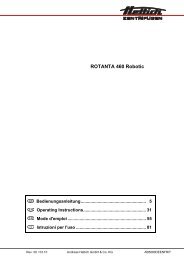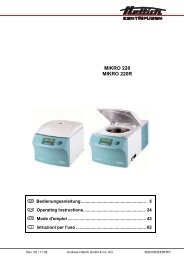Slide preparation of cerebrospinal fluid for cytological examination
Slide preparation of cerebrospinal fluid for cytological examination
Slide preparation of cerebrospinal fluid for cytological examination
- No tags were found...
Create successful ePaper yourself
Turn your PDF publications into a flip-book with our unique Google optimized e-Paper software.
Hettich Application Note<strong>Slide</strong> <strong>preparation</strong> <strong>of</strong> <strong>cerebrospinal</strong> <strong>fluid</strong><strong>for</strong> <strong>cytological</strong> <strong>examination</strong>
<strong>Slide</strong> <strong>preparation</strong> <strong>of</strong> <strong>cerebrospinal</strong> <strong>fluid</strong> <strong>for</strong> <strong>cytological</strong> <strong>examination</strong>In liquor diagnostics, conventional liquorcytology plays an important role in the detectionand classification <strong>of</strong> infectious inflammatorydiseases <strong>of</strong> the CNS, in the detection <strong>of</strong> bleedingsin subarachnoid spaces and in the discovery<strong>of</strong> neoplastic cells. In addition, <strong>cytological</strong><strong>preparation</strong>s are used <strong>for</strong> follow-up tests andtherapy control. 1)As <strong>cerebrospinal</strong> <strong>fluid</strong> usually contains fewcells and little albumin, cells start suffering damagea few hours after punction. There<strong>for</strong>e, liquorsamples taken to prepare slides <strong>for</strong> <strong>cytological</strong><strong>examination</strong> should not be older than 2 hours. 2)Not only is the age, but also the processing<strong>of</strong> the samples <strong>of</strong> vital importance <strong>for</strong> thediagnostic value <strong>of</strong> the <strong>preparation</strong>s. Good<strong>preparation</strong>s <strong>of</strong> <strong>cerebrospinal</strong> <strong>fluid</strong> requireoptimal cell recovery and the preclusion <strong>of</strong>selective cell loss. The morphology <strong>of</strong> the cellsneeds to be maintained to enable a correctidentification <strong>of</strong> the different cell populations.Preparation1. Sample <strong>preparation</strong>Often the quality <strong>of</strong> <strong>preparation</strong>s <strong>of</strong> cell- and albuminpoorliquor samples is not satisfactory. We, there<strong>for</strong>e,recommend adding human serum or albumin solution.The addition <strong>of</strong> albumin to samples with cell countsbelow 10/µl and albumin rates below 3000 mg/lis considered vital <strong>for</strong> the stabilisation <strong>of</strong> cells. Toguarantee an albumin concentration above 3000 mg/l,50 µl normal serum with a total protein content <strong>of</strong>approx. 70 g/l is added to a liquor sample <strong>of</strong> 400 µl.Autogenic serum is not required. 3)The use <strong>of</strong> coated slides can also increase cellyield. For routine and conventional staining it isrecommended to use slides coated with Polysine TM ,<strong>for</strong> the immuno<strong>cytological</strong> detection <strong>of</strong> cellularsurface marker, particularly tumour markers it isrecommended to use Super Frost ® Color slides. 4)(Polysine TM and Super Frost ® are registeredtrademarks <strong>of</strong> the Gerhard Menzel GlasbearbeitungswerkGmbH & Co. KG).2. Suitable accessoriesAdvantages <strong>of</strong> the Hettich method1. Immediate processing <strong>of</strong> the liquor samples· Suitable <strong>for</strong> samples <strong>of</strong> various cell content and different· volumes up to 8 ml· Use <strong>of</strong> the cell-free supernatant <strong>for</strong> further analyses2. Excellent <strong>preparation</strong> quality· Optimal preservation <strong>of</strong> the morphology· Optimal spreading <strong>of</strong> the cells· Optimal yieldThe available quantity and the cell content <strong>of</strong> thesamples determine the adequate chamber.With liquor samples, we generally recommend theuse <strong>of</strong> 1 ml and 2 ml chambers with sedimentationareas <strong>of</strong> 30 mm² or 60 mm².cells/sample up to 2,000 2,000 – 20,000 more than 20,000sedimentation area 30 mm² 30 mm² 60 mm²Kammern mit Sedimentflächen von 30 mm² bzw. 60mm² zu empfehlen.volume 100 µl – 1 ml 100 µl – 1 ml 400 µl – 2 mladdition <strong>of</strong> albumin yes no no3. Assembly <strong>of</strong> the cyto insertHow to assemble a cyto insert can be learnt fromour leaflet „Perfect <strong>preparation</strong>s – with the HETTICHcyto-system all it takes is a turn“. <strong>Slide</strong> <strong>preparation</strong>s<strong>of</strong> liquor <strong>cerebrospinal</strong>is usually require dry fixation.For this reason, the insert should be assembled witha filter card (see illustration B1 in above mentionedleaflet). When working with infectious samples, theinserts should be closed with hygienically sealed lidno. 1661 (see illustration B2 in above mentioned leaflet).1) Kluge et al., Stellenwert der praktischen (klassischen) Liquorzytologie im Gesamtspektrum der Liquordiagnostik, in Kluge et al. (Hrsg.)Atlas der praktischen Liquorzytologie, Stuttgart 2005, p. 2-3.2) Ibidem, p. 7.3) Ibidem, p. 8.4) Recommended by the Liquor Laboratory <strong>of</strong> the Institute <strong>for</strong> Clinical Chemistry and Laboratory Diagnostics (Pr<strong>of</strong>. Dr. Kluge, Dr. Roskos) <strong>of</strong> the Clinical Centre <strong>of</strong> the University <strong>of</strong> Jena. 2
<strong>Slide</strong> <strong>preparation</strong> <strong>of</strong> <strong>cerebrospinal</strong> <strong>fluid</strong> <strong>for</strong> <strong>cytological</strong> <strong>examination</strong>4. Centrifugationa) SedimentationCentrifuge the cyto chambers <strong>for</strong> 3 minutes at 275 x g(this corresponds to 1,500 min -1 with the 6-place rotorand 1,700 min -1 with the 4-place rotor).During centrifugation, the cells sediment onto the slide.b) Removal <strong>of</strong> the cell-free supernatantAfter centrifugation, the cell-free supernatant is stillwithin the chamber and needs to be removed except<strong>for</strong> a small remainder. When draining the chamber,take care not to stir the sediment. Otherwise, thequality <strong>of</strong> the <strong>preparation</strong> will suffer and cells may getlost. We advise to use a Pasteur pipette <strong>for</strong> removingthe supernatant. Do not position the tip <strong>of</strong> the pipetteon the slide, but follow the liquid level with it carefullydownwards. Do not drain the chamber completely,but leave a drop <strong>of</strong> supernatant on the sediment!If no albumin has been added to the sample, therecovered supernatant may be used <strong>for</strong> biochemicalanalyses.c) Drying the sedimentWith the most frequently per<strong>for</strong>med Giesma method <strong>of</strong>staining, the sediment needs to be dry. Dry the sedimentby centrifuging it a second time.After the supernatant has been removed, twist <strong>of</strong>f thefastening ring and lift it <strong>of</strong>f with the chamber (seeillustration B4). Put the cyto suspension with slidecarrier, slide and filter card back into the centrifugeand spin <strong>for</strong> 1 minute at 1,100 x g (this correspondsto 3,000 min -1 with the 6-place rotor and 3,400 min -1with the 4-place rotor).The residual supernatant is spun <strong>of</strong>f by centrifugal<strong>for</strong>ce and absorbed by the filter card. The cells whichconstitute the sediment stay on the slide. They arewell preserved and ideally spread. By drying the<strong>preparation</strong> by centrifugation, evaporation artefacts likeshrunk leucocytes or crystallisations can be avoided.d) Fixing and stainingThe dry <strong>preparation</strong> can be fixed and stained immediately.Good to know:In the final stage <strong>of</strong> the Giemsa and May-Grünwald-Giemsa methods <strong>of</strong> staining, the slides are rinsed witha buffer (Weise, Sörensen). Thereafter, they need tobe dried.This can be done quick and easily with thelabora-system frame <strong>for</strong> 6 slides (Cat. No. 1285).· Put the slides rinsed with Weise buffer into the frames,· and put the frames into the centrifuge.· Centrifuge <strong>for</strong> 1 minute at 275 x g (this corresponds ·· to 1,500 min -1 in the 6-place rotor, 1,700 min -1 in the ·· 4-place rotor).· Take the frames containing the dry slides out <strong>of</strong> the·centrifuge.· The <strong>preparation</strong>s are ready <strong>for</strong> <strong>examination</strong> under the· microscope and/or mounting now.· Wipe the cyto suspensions dryWith the 6-place rotor up to 36 slides can be driedat a time.Ordering in<strong>for</strong>mationCentrifugeCat. No.ROTOFIX 32 A 1206UNIVERSAL 320 / UNIVERSAL 320 R 1401 / 1406Selected accessories 5)Cat. No.4-place rotor 16246-place rotor 1626cyto suspension 1660lid fitting onto 1660 1661slide carrier with fastening ring 1662cyto chamber 1 x 1 ml (30 mm²) 1663cyto chamber 1 x 2 ml (60 mm²) 1664filter cards <strong>for</strong> 1663 and 1664, pack <strong>of</strong> 200 1675labora-system frame <strong>for</strong> 6 slides 12855) The complete range <strong>of</strong> Hettich cyto accessories is listed in our brochureon cyto centrifugation, which can be ordered free <strong>of</strong> charge.Andreas Hettich GmbH & Co. KGFöhrenstr. 12D-78532 TuttlingenGermanywww.hettichlab.cominfo@hettichlab.comservice@hettichlab.comPhone +49 (0)7461/705 -0Fax +49 (0)7461/705 -122National Sales: -200International Sales: -201National Service: -202International Service: -203
















